Why preserving culture is at the heart of Sustainability Hospitality
The thought of Italy has everyone dreaming. Oooey gooey pasta, endlessly flowing wine (I mean, they invented the phrase “table wine,” right?) and the romanticism of a time and place preserved from long ago, where Caesar ruled and Jesus was said to walk the streets. For me, who had only ventured to the most well-known cities (i.e., Roma, Venice, and Florence), travelling to Piedmont (or Piemonte, in Italian) was a beautiful mystery. Residing at the base of the Italian Alps, I sought out this specific UNESCO World Heritage Site (appointed for its beauty and for the historical meaning of the landscape) due to the newly opened “sustainable luxury hotel,” Casa di Langa.” I was confident there would be heartfelt pleasures such as personalized service and no single-use plastic. What would come as a surprise to me was how sustainability would be the catalyst for the preservation and pride in the rich history of the area. Or could it be the other way around? Had culture been the catalyst for sustainability? One thing was certain; anyone visiting Piedmont would be changed by the beauty of the landscape, the passion of the people, the rich history of wine and food, and how slowing down is the only way these luxuries can truly be appreciated fully.
Sustainability
When we think of the words “eco-friendly” and “sustainability,” we typically think of “reduce,” “reuse,” “recycle” or “carbon footprint,” or any endeavor that encourages the conservation and protection of the natural world. This was different from what I had experienced before. Piedmont had the power of enveloping people in a new way of life, which I’m certain the locals would say “was under the guise” of sustainability, but for the people local to the area, this is the only way they know how to live.
Sustainability can be an abstract concept at times, but what Casa Di Langa taught me was that sustainability solutions do not have to be complicated; they can be as simple as having the ability to slow down in a world living at a warp speed. This idea is ingrained in every part of life. The area has managed to not miss out on anything and take advantage of everything their natural resources have to offer, simultaneously enriching local life immensely. Piedmont embodies sustainability through the concept of “slow living,” and for anyone visiting it’s a guarantee one will at least adhere to this while visiting the area. Whether it is something we can embrace when we get home is yet to be determined.
How to get to Piedmont
It’s not easy to get to Piedmont (a common theme of mine at times), a short three-hour ride from the French Riviera, bordering both France and Switzerland. You travel up elevation on windy roads to reach Piedmont, which sits at the foot of the mountain; its name in Italian means “foot of the mountain” (“pie” for “foot” and “monte” for “mountain”).
Each turn led me to the hope that I would soon calm the car sickness. Casa di Langa is located in the upper “Langhe” region, the first of the hills to emerge from the oceans and rivers 30,000,000 years ago. Luckily, being transported by the gorgeous landscape, miles of vineyards and the feeling of a place that takes great care of the land and each other helped mute my nausea. One gets a feeling it is special before you step a foot outside of the car. The blue sky atop a layered orange and purple skyline, with miles and miles of vineyards on the horizon. Well known for the famous Barolo, Barbaresco, and Alta Langa wine regions. Beyond a quick ride through Alba (the closest major city is Piedmont), you find yourself immersed in a special place.
Geography
As a self-proclaimed truffle addict, I didn’t realize Alba is where they have one of the largest annual truffle festivals and only one of two places in the world where white truffles are found, due to former sea and the consequent floods, erosion, and earthquakes that gave birth to a unique, special soil composition also responsible for the beautiful wines produced.
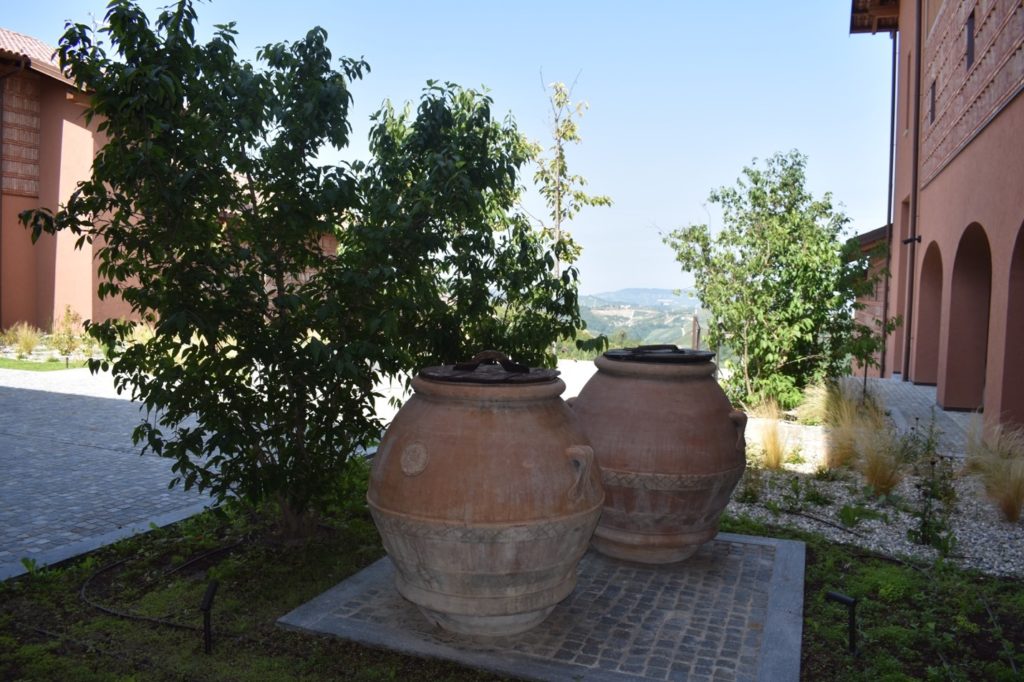
The farther up the mountain we went, the fewer homes and businesses we saw. Finally, we came upon what seemed to be a modest building in the valley that appeared very traditional and blended into the landscape, due to its colors and materials. A deliberate technique that blends the built environment with the natural one in order to maintain the character of hundreds of years of history. As Eva the GM stated, “We were careful to be as immersive into the landscape as possible when it came to the building.” It is also a great way of supporting local companies that supply all of the building materials. The building was already partially built when acquired and for both sustainability and cultural reasons, 80% of it was kept and the remaining 20%, retrofitted.

The hotel was almost reminiscent of a fortress. Keeping all the magic and mystery beyond the walls. When we pulled up, we were greeted warmly and taken into the reception area. As you enter the hotel you notice it adorned with artifacts and beautiful pieces of art – telling the story of the people and place you couldn’t help but want to learn more about. Just beyond the reception and bar area you could see the natural setting to be discovered. Walking through the lobby you begin to witness the vastness of the surroundings. Everywhere the eye can see are vineyards and rolling hills creating the most beautiful spectacle of colors: from deep greens and sky blues to magentas and burnt orange, dependent on the time of day. The culmination of the landscape and the open-air feel of the hotel provides the ultimate feeling of wellness, one of being supported and sheer serenity. It felt as though no one could find you.

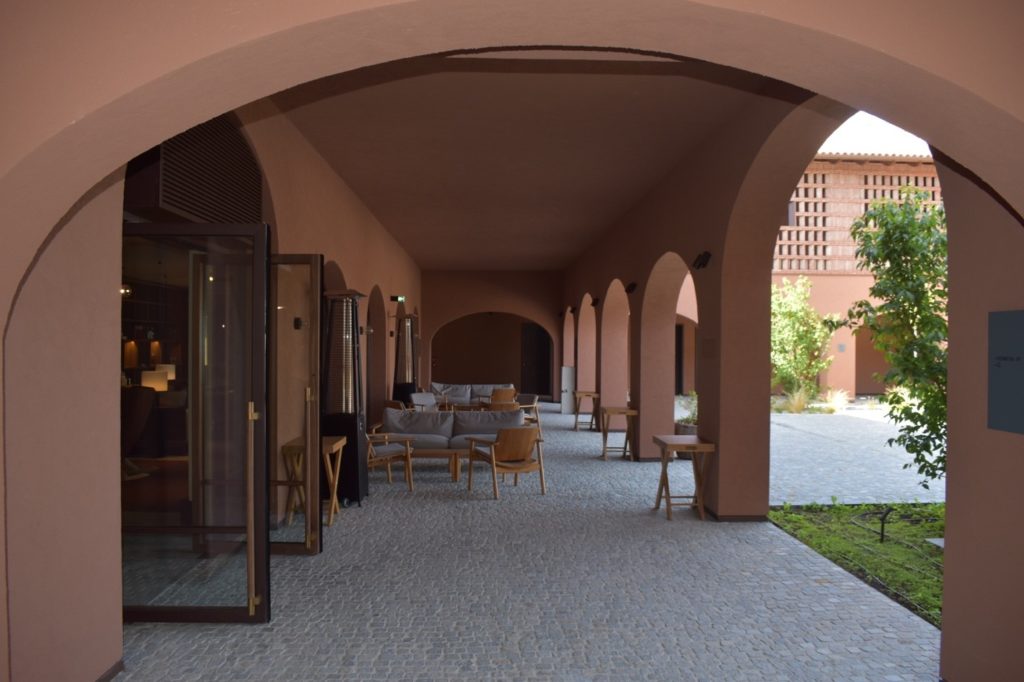
Each room is luxurious, comfortable, and modern, yet still feels perfectly minimal. All of the rooms are filled with colorful artwork, revealing a reflection of the passion and pride of the people in the area. Glass carafes are provided and refilled with water from the local aquifer – an obvious ode to their plastic-free operations initiative.

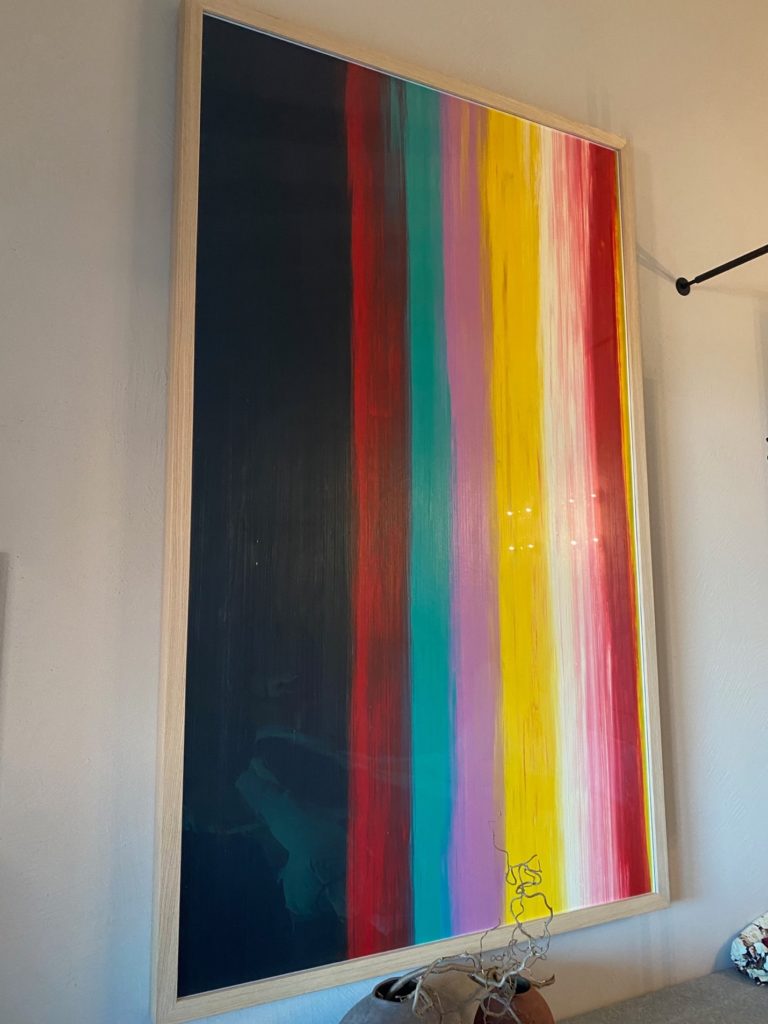
I was curious about the drivers behind the hotel and its inception, so I sat down with Eva the GM to find out the inspiration behind the hotel and how the vision they had would translate to the guests’ experience.
My Interview with Eva the hotel GM
What is your definition of sustainability?
Casa Di Langa is “Luxury through Sustainability.” I believe it is having everything you need, not having any issues, and providing all the services necessary. It becomes a reason to exist. Luxury is the time our guests have decided to devote to us. Not only by staying with us, but by inquiring about specifics about the property, the land, and the local culture.
Who was the driver behind reducing the hotel’s environmental footprint, striving to be a Sustainable Luxury Hotel?
The owner of the hotel had the idea long before acquiring a partnership with Preferred Hotels. They own convenience stores in the states in Idaho and also have a few vineyards – sch as Enrique Serrafino.
I noticed in the literature in the room there is mention of recycled water, carbon-neutral and traditional buildings. Can you tell me a bit about that and how those systems work? Can you tell me about any other systems/initiatives you are excited about?
We recycle water for irrigation and plants and are soon to be carbon-neutral with the use of our solar field. Until that is complete, we buy green energy to power the property.
We use geothermal and we have plastic-free operations. If we must we use plastic we try to ensure the packaging at least comes from recycled plastic.
In a world where sustainability is a buzzword, how do you see Casa Di Langa standing out?
“We will have an art collection on property that will lend a uniqueness and special interaction with the guests and it will allow our staff the ability to share the stories behind each piece. It is an ability to learn from each other, and our special outdoor spaces (i.e., gardens, etc.)
Hotel offerings
Aside from the spa, exquisite dining and gorgeous pool overlooking the valley of vineyards, there is a multitude of activities to choose from to completely immerse yourself into the area’s unique perspective and culture. From wine tastings, (on or off property) to cooking classes, and TRUFFLE HUNTING – You heard me! You too can have a guide and a dog who whisks you deep into the enchanted forest and shows you how to sniff out those OH SO LUXURIOUS nuggets of goodness. Whatever you choose to spend your time doing, it is inevitable you will bathe in the beauty and harmony of the land.
In reflection
When we travel to places that we aren’t visiting just to see what is representative of today, are we really traveling? Aren’t we mystified by the past? The lure is to feel as though we are experiencing a time and place that is different from ours, that we can learn from and be inspired by and crave to know more about. What we have heard stories about and read about in books. As Eva stated, “Casa Di Langa reminds you of what used to be, and they remain the traditions from the past.”

One of the reasons I feel so compelled to seek out these extraordinarily unique places is, of course, the beauty. But there is such a feeling of connectedness, no only to the place but also to the other travelers who are sure to be like-minded and hoping for the same wonderful cultural lessons to package up and take home by way of memories. The wonderful reminder that we are all so alike; it is just miles that separate us.
I am sure this is only the beginning of the transformation Casa di Langa will leave on its guests. I believe many destinations want to share their history with the world, similar to Casa di Langa; moreover, what the past few years have taught us is that it must be done in a way that regenerates and preserves their way of life, not degrades it.
A trip to Casa Di Langa encourages you to expand your mind and stop and be present. It floods you with curiosity to know more about the area and delights you with new food and wine experiences. Vastly different from the hurried and action-packed trips focused on checking off each attraction and point of interest while snapping as many photos as you can. Not slowing down long enough to savor, stop, and be present.
As with all holidays, ours eventually came to an end. I found myself jolted back into reality on an airplane with my N95 mask on, wiping down everything with a disinfecting wipe. The memories of Casa di Langa would never leave me but felt far, far away.
As I scrolled through the movies on the plane, I couldn’t believe my eyes. When I got to The Truffle Hunters, a movie set in Alba documenting the life of truffle hunters and their beloved companion dog, it felt so serendipitous and I immediately felt a rush of emotion and longing to be back in Piedmont. I cherished the next two hours and felt transported back to the place I loved visiting and vowed I would see again.
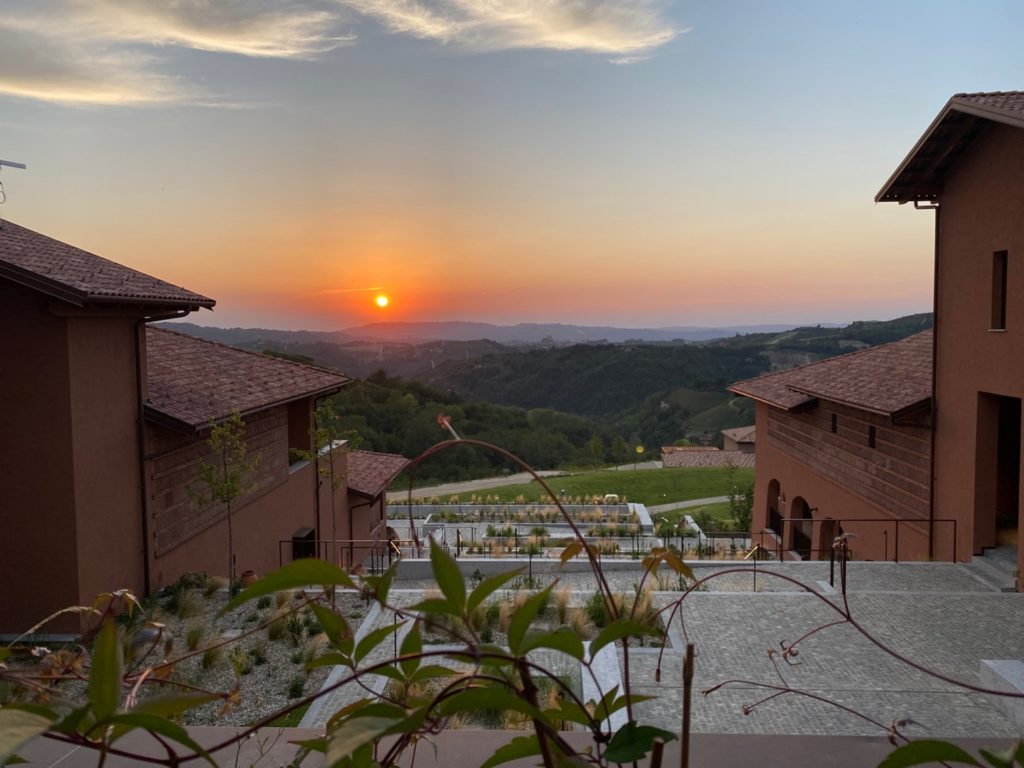
Turning the traveler into a conservationist is our mission at Green Luxe.
We hope you find motivation in nature and inspiration in travel.
Dreaming of our next adventure,
XX Amy
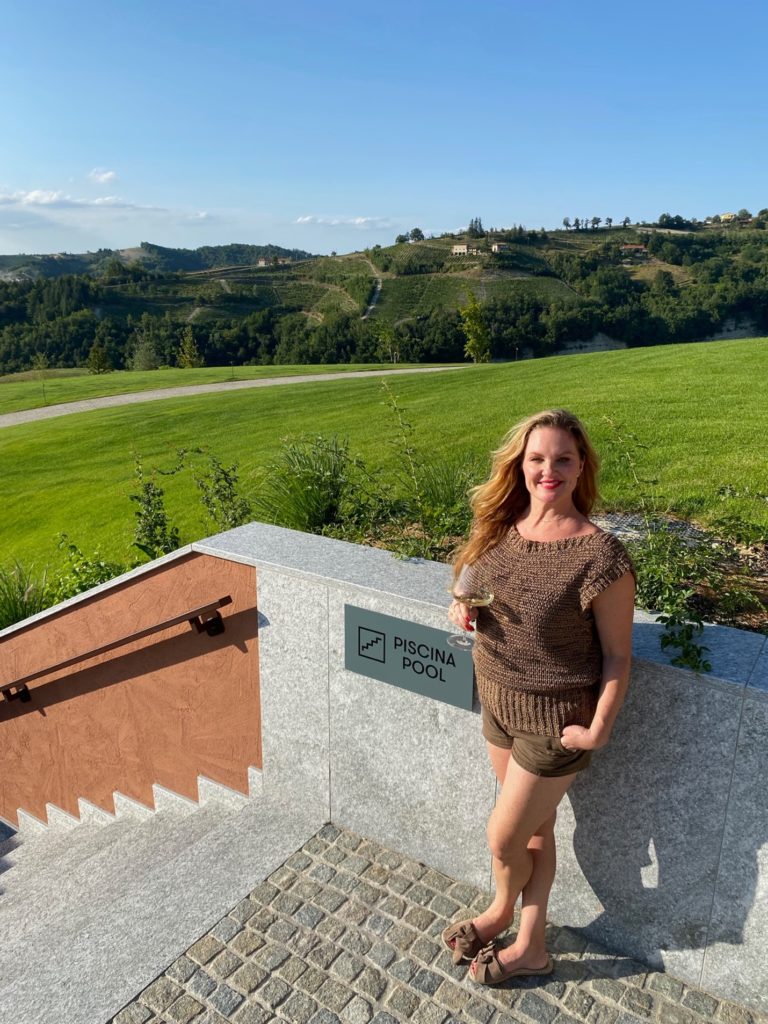


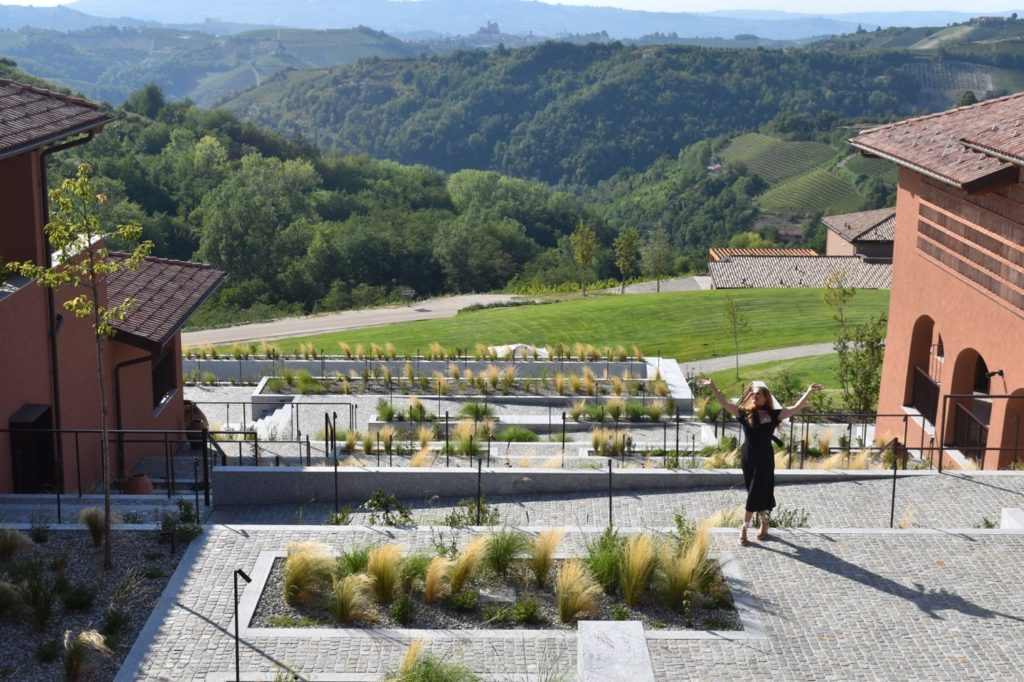
Recent Comments